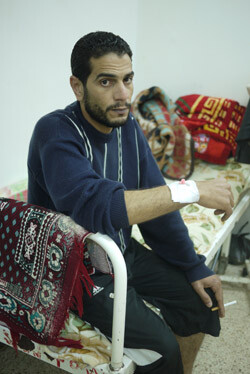The Electronic Intifada 3 March 2011

Imed Halissa Seli (Mike Elkin/IPS)
Al-Jalah, the only emergency hospital in the city with neuro and orthopedic surgeons, received most of the victims of the carnage.
On Saturday 19 February, Adel al-Salini, 29, was on way to the cemetery to bury his older brother Ayet, who had been killed the day earlier by Gaddafi’s men. As they got out of the cars, mercenaries in camouflage uniforms started shooting at the mourners.
Adel was hit just under the right rib, and his liver and kidneys were damaged. Doctors operated on him, leaving a long scar down the middle of his stomach, but he will make a full recovery. “Alhamdulilah,” he said, the Arabic expression for, “thank god.”
Imed Halissa Seli, 31, lives in a neighborhood next to an army base. On the same Saturday he started hearing shouting and shooting outside, and he went out to see what was happening. “Some Libyan and black African men in long, black coats were climbing over the base wall into the streets,” he said.
“They started shooting at anyone they could see. I was hit. Residents hid until the mercenaries went into the middle of the street, and then everyone attacked them from all sides with rocks, swords and axes. We caught one of them and turned him over to the Bengazi security committee.”
Shot in the back of the neck, Seli had to wait seven days for surgery because there were other patients with more serious injuries ahead of him.
Doctors have told the Red Cross that 256 people were killed and 2,000 injured in Benghazi during the uprising.
At the hospital morgue, forensic doctors said they had little room to work, with all the bodies being wheeled in. The bodies of two of Gaddafi’s mercenaries — one apparently Libyan, one from another African country — are still rotting.
Forensic experts are also working on identifying the charred remains of nine soldiers who allegedly were shot and burned because they refused to fire on the people.
Three masked doctors sifted through one black mass — roughly the neck to the upper thigh of one soldier. Using a small, circular drill, one doctor cut into the femur to extract bone that will be tested for DNA. Eight other bodies in green body bags sit on the floor in an adjacent room.
“We need to do this to identify the bodies,” said Dr. Sabah, one of the forensics trying to find a suitable piece of bone for the sample. “This room looks empty now, but last week it was packed to capacity. Families keep coming here looking for missing relatives.”
At the Benghazi Medical Center, a gigantic, new hospital on the outskirts of downtown, the casualty situation wasn’t as dire as at al-Jahal, but what the doctors saw enraged them. “The casualties here were mainly gunshot wounds to the head, chest, abdomen — mostly young people under 25,” said hospital director Dr. Jamal Eltalhi.
“Some arrived dead, some died here. And not just normal gunshots, but also heavy artillery. The size and type of these injuries were horrific. Some were cut in half. Every single patient admitted to this hospital was a gunshot victim and in a shoot-to-kill style.”
Fears of an attack from Gaddafi, however, are not far from the minds of Benghazi’s citizens.
“We are all on full alert because we don’t know what will happen next,” Eltalhi said. “But we are managing with the minimum number of nurses and doctors. We cannot open wards. We have no outpatient services running because of the shortage of staff and supplies. We have a shortage of cancer, diabetic and epileptic drugs.”
“These are all vital drugs, but they have not been a priority over the past few days. If anything happens in Benghazi, this hospital will have no chance to cope. We couldn’t even cope with a large car accident. But we must also focus on what’s happening in the western part, which is a real crisis,” Eltalhi said.
“There is killing every day. In Tripoli they are killing people and taking their bodies away so no one can see them. My mother is stuck in Tripoli, and she told me over the phone that no one can leave their houses for food. Everyone is hiding in their homes looking for an answer to a question that is uncertain.”
All rights reserved, IPS — Inter Press Service (2011). Total or partial publication, retransmission or sale forbidden.



